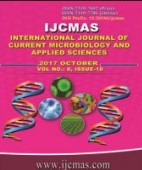


 National Academy of Agricultural Sciences (NAAS)
National Academy of Agricultural Sciences (NAAS)

|
PRINT ISSN : 2319-7692
Online ISSN : 2319-7706 Issues : 12 per year Publisher : Excellent Publishers Email : editorijcmas@gmail.com / submit@ijcmas.com Editor-in-chief: Dr.M.Prakash Index Copernicus ICV 2018: 95.39 NAAS RATING 2020: 5.38 |
An experiment on integrated nutrient management in French bean was conducted during 2016-17 with the treatments being T1 (RDF), T2 (RDF + lime), T3 (75% RDF), T4 (75% RDF + lime), T5 (75% RDF +25% FYM), T6 (75% RDF + 25% FYM + lime), T7 (75% RDF + 25 % vermicompost), T8 (75% RDF + 25% vermicompost + lime), T9 (75 % RDF + 12.5 % vermicompost + 12.5 %FYM + lime), T10 (50% RDF +25% FYM + 2 foliar spray), T11 (50% RDF +25% vermicompost + 2 foliar spray). On the course of investigation, it was observed that the number of pods per plant was highest in T8 (15.00) and T9 (15.00) followed by T7 (14.10), length of pod was highest with T8 (13.80 cm) followed by T9 (13.20 cm), dry weight of pod per plant was highest in T8 (50.10 g) followed by (48.00 g) in T9, number of seeds per plant was highest in T5 (78.40) followed by T8 (74.52) and dry weight of seeds per plot was highest in T8 (1653.00 g) followed by T9 (1587.00 g). However the seed yield per hectare was highest in T8 (18.00 q/ha) followed by 16.65 q/ha in T9 and 16.56 q/ha in T6 and the lowest seed yield of 11.76 q/ha was obtained in T11. It can be concluded that application of 75% RDF along with 25% vermicompost and lime application produced a good environment supporting very good growth of French bean to produce significantly higher marketable seed yield during rabi season under coastal agro climatic condition of Odisha.
 |
 |
 |
 |
 |